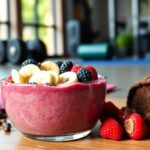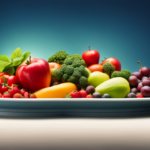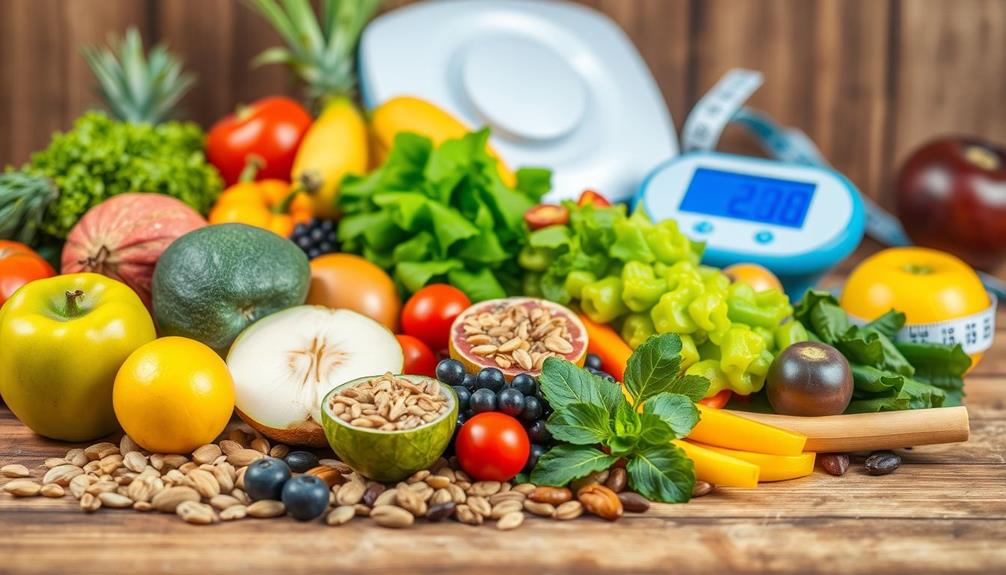The Raw Food Diet can definitely promote exercise by fueling your body with nutrient-dense foods that boost energy and enhance recovery. The high fiber and water content in raw foods help maintain stable energy levels, making it easier for you to stay active. Nutrients from fruits, vegetables, and healthy fats from nuts and seeds support muscle repair and reduce inflammation post-workout. While the diet requires careful planning to avoid nutrient deficiencies, it can ultimately enhance your physical performance. If you want to learn more about how to effectively combine this diet with your fitness routine, keep exploring! Additionally, the high water and fiber content in raw foods can contribute to a feeling of fullness, which may aid in weight management. Many individuals turn to the raw food diet for weight loss because of its emphasis on whole, unprocessed foods and the potential for reduced calorie intake. However, it’s important to be mindful of portion sizes and overall calorie consumption to ensure a well-rounded and sustainable approach to weight loss. If you’re considering incorporating the raw food diet for weight loss, consulting with a nutrition professional can provide valuable guidance and support.
Key Takeaways
- The raw food diet's high nutrient density fuels energy levels, enhancing exercise performance and recovery.
- Hydrating raw foods help replenish fluids and reduce muscle soreness post-workout.
- High fiber content promotes stable energy levels, preventing crashes during physical activity.
- Nutrient-rich raw foods support muscle recovery by reducing oxidative stress and inflammation.
- Meal planning is crucial to ensure adequate caloric intake for active lifestyles on a raw food diet.
Understanding the Raw Food Diet
What makes the raw food diet appealing to many people? The raw food diet emphasizes eating uncooked foods, primarily fruits, vegetables, nuts, seeds, and sprouted grains. By focusing on organic options, it aims to preserve vital nutrients and natural enzymes believed to aid digestion.
You'll find that foods mustn't be heated above 104–118°F (40–48°C) to maintain these beneficial properties. Many advocates also claim that incorporating raw juices, like celery juice, can enhance hydration and detoxification, further complementing the raw food lifestyle.
Food preparation plays a significant role in this diet. Methods like juicing, blending, dehydrating, soaking, and sprouting help maximize nutrient intake while keeping your meals raw.
Many advocates tout health benefits such as improved energy levels and weight loss, along with a reduced risk of chronic diseases. However, you should be aware that scientific evidence supporting these claims is limited.
While the raw food diet can be an exciting way to embrace a plant-based diet, it may also lead to nutrient deficiencies, especially in vitamin B12, iron, and omega-3 fatty acids.
Careful meal planning and potential supplementation are necessary to guarantee you meet your nutritional needs while enjoying the benefits of this lifestyle.
Nutritional Benefits of Raw Foods
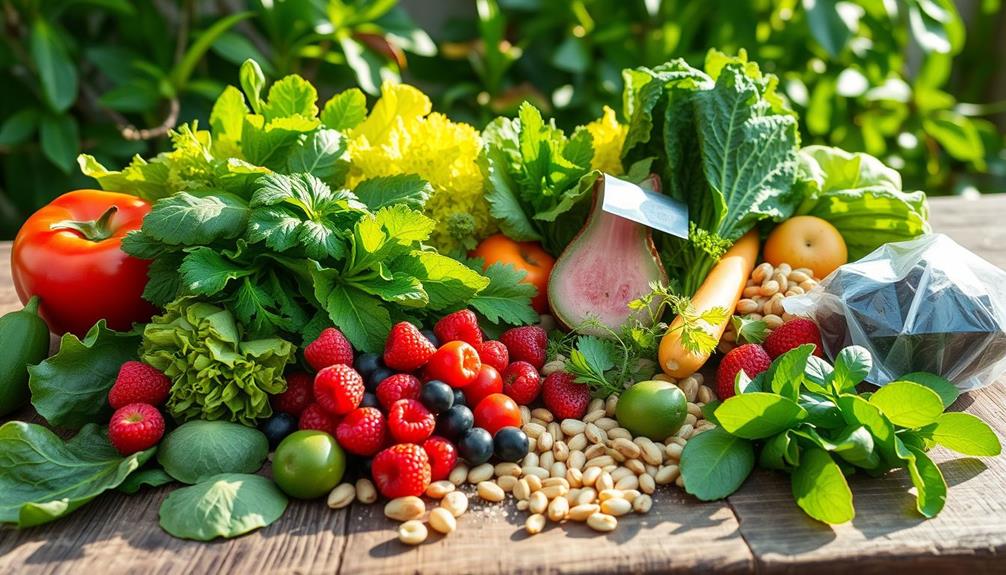
When you embrace a raw food diet, you'll discover its impressive nutrient density, packed with vitamins and minerals that boost your health.
The high fiber content not only aids digestion but also keeps you feeling full, which is essential for maintaining energy during workouts.
Additionally, the natural sugars found in fresh fruits can provide a quick energy boost before exercise, while the hydration from fresh fruits and veggies supports your recovery, helping you bounce back stronger after exercise.
For those interested in optimizing their performance, caffeine may enhance endurance during workouts.
Nutrient Density Advantages
While many diets can provide essential nutrients, raw foods stand out for their exceptional nutrient density, offering numerous health benefits that support both overall well-being and exercise performance.
These nutrient-dense options are high in vitamins and minerals, which are vital for maintaining your body's functions and enhancing your workouts. Incorporating raw foods into your diet can also support your immune system and improve recovery times after exercise, as seen with the antimicrobial properties of certain essential oils that can help reduce inflammation.
When you incorporate raw foods into your diet, you boost your energy levels, allowing for improved endurance and stamina during exercise.
Additionally, the high fiber content of raw fruits and vegetables promotes satiety, making it easier for you to manage your weight effectively. You can enjoy larger portions without exceeding your caloric needs, which means you can fuel your workouts while supporting weight management.
The diverse range of phytochemicals found in raw foods can also help reduce inflammation and aid in muscle recovery after intense physical activity.
Fiber and Digestion
Eating a raw food diet often leads to improved digestion, thanks to the high fiber content found in fruits and vegetables. This fiber plays a vital role in promoting regular bowel movements and preventing constipation, which is essential for maintaining gut health.
Raw foods are rich in both soluble and insoluble fiber, helping to lower cholesterol levels and stabilize blood sugar, further supporting digestion. Additionally, a diet high in fiber can enhance your overall health and may even support gout-friendly dietary choices, as it encourages the consumption of fruits and vegetables.
Moreover, the fiber-rich nature of raw foods enhances satiety, making you feel full longer. This can help reduce overall calorie intake, aiding in weight management. By consuming a variety of raw fruits and vegetables, you also receive essential nutrients and antioxidants that bolster digestive health and may reduce inflammation in the gut.
Research shows that diets high in dietary fiber are linked to a lower risk of developing gastrointestinal disorders, such as diverticulitis and colorectal cancer.
Hydration and Recovery
How can a raw food diet enhance your hydration and recovery after exercise? Incorporating raw foods into your diet can notably boost your hydration levels, thanks to their high water content. Fresh fruits and vegetables, like watermelon and cucumber, not only keep you hydrated but also replenish essential vitamins and minerals that support recovery.
These nutrients help reduce inflammation and promote faster healing after intense workouts. Additionally, many elements of a proper diet, such as fresh fruits and vegetables, play an essential role in maintaining overall health and wellness, similar to proper hamster care.
Additionally, raw foods provide quick energy sources, such as bananas and nuts, which are perfect for fueling your workouts and restoring glycogen stores post-exercise. Their low-calorie density allows you to enjoy larger portions without worrying about excessive caloric intake, helping you maintain energy levels throughout the day.
Moreover, the fiber in raw fruits and vegetables supports digestive health, ensuring your body efficiently absorbs all those important nutrients. This is especially important for active individuals who require ideal nutrition to perform at their best.
Raw Food Diet and Energy Levels
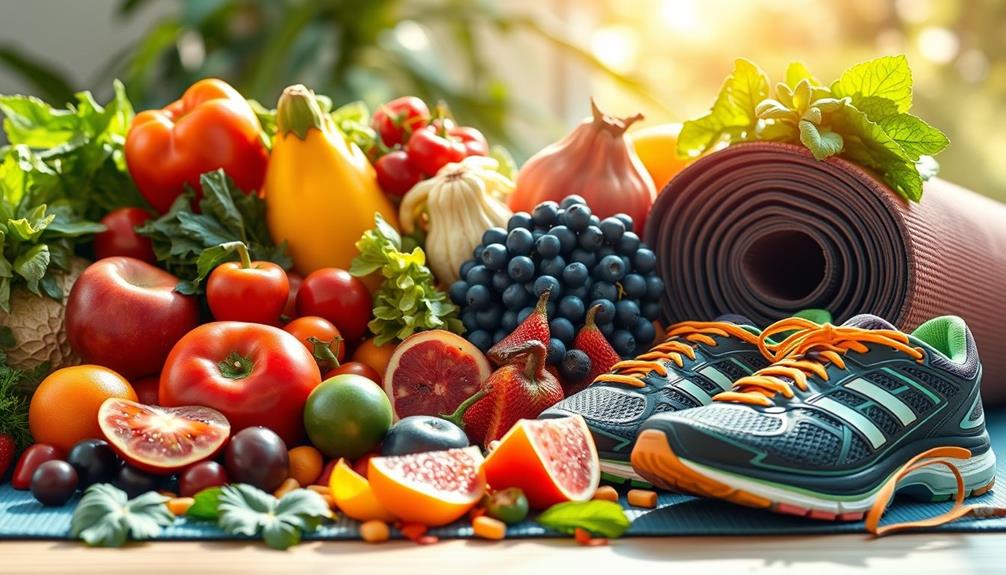
The raw food diet's abundance of vitamins, minerals, and antioxidants can greatly boost your energy levels. By consuming fresh fruits and vegetables, you're fueling your body with fundamental nutrients that enhance overall vitality.
The high fiber content in raw foods aids digestion, leading to sustained energy throughout the day. Unlike processed foods, which can cause energy crashes, raw foods help keep your energy levels stable. Additionally, maintaining a balanced diet rich in fruits and vegetables is critical for optimizing health and energy.
Many advocates of the raw food diet report increased endurance and stamina during physical activities. This improvement in exercise performance is often linked to the nutrient density of their meals.
Furthermore, a 2005 study showed that individuals on a raw food diet experienced reduced cholesterol and triglycerides, contributing to better cardiovascular health.
However, it's important to keep in mind that some raw foods can be low in calories. If you're engaging in intense exercise, you might need to focus on meal planning to guarantee you're getting enough energy.
Balancing your nutrient intake is imperative to support your active lifestyle while enjoying the benefits of a raw food diet. By doing so, you'll feel more energized and ready to tackle your daily activities.
Impact on Physical Activity

When you adopt a raw food diet, you might notice changes in your energy levels that can influence your physical activity.
The high nutrient density of fruits and vegetables can boost your recovery and enhance your performance during workouts.
Additionally, incorporating herbal teas like chamomile and ginger may help alleviate any discomfort you experience, allowing you to stay active.
However, it's important to keep an eye on your protein intake to guarantee you're supporting your muscle function effectively.
Nutrient Density and Energy
A raw food diet can greatly enhance your energy levels and overall physical activity. By focusing on nutrient-dense foods, you can fuel your body effectively.
Additionally, raw foods support digestive health with their high water content and fiber, boosting immune system function due to their abundance of vitamins and antioxidants.
Here are four key benefits of incorporating raw foods:
- High Fiber Content: Raw fruits and vegetables promote digestion and provide sustained energy, helping you maintain stamina during workouts.
- Weight Management: Raw foods are typically lower in calories and unhealthy fats, which can help you achieve a healthier body composition and improve exercise performance.
- Healthy Fats: Foods like nuts and seeds offer essential healthy fats and proteins, important for energy replenishment and supporting muscle recovery post-exercise.
- Hydration: The high water content in many raw foods guarantees you're well-hydrated, essential for peak physical performance and recovery.
Muscle Recovery Benefits
Maximizing muscle recovery is fundamental for anyone engaged in regular physical activity, and a raw food diet can play a considerable role in this process. By focusing on a diet rich in fruits and vegetables, you can harness the power of antioxidants, which help reduce oxidative stress and inflammation after intense workouts. This reduction is critical for effective muscle recovery.
Additionally, incorporating raw foods can enhance overall wellness and energy levels, which are essential for maintaining an active lifestyle; for example, many individuals find that yoga for back pain helps them remain agile and flexible, supporting their physical activities.
The high fiber content in raw foods aids digestion, enhancing nutrient absorption, which is essential for repairing and building muscle post-exercise. Incorporating raw nuts and seeds into your diet provides healthy fats and proteins that support muscle growth and recovery. These elements work together to guarantee your muscles get what they need to bounce back stronger.
Moreover, raw fruits and vegetables help maintain hydration levels, an often overlooked aspect of recovery. Staying hydrated is key for peak physical performance and recovery following exercise. Many people on a raw food diet report improved energy levels, which can boost your motivation to stay active.
Raw Foods for Muscle Recovery

Eating raw foods can greatly boost your muscle recovery after intense workouts. By incorporating these nutrient-dense options into your diet, you can enhance your body's ability to repair and grow muscle tissue. Individuals with Borderline Personality Disorder (BPD) may benefit from a nutrient-rich diet, as it can support emotional regulation and overall well-being.
Here are four key benefits of raw foods for muscle recovery:
- Rich in Nutrients: Raw foods packed with vitamins and minerals provide essential nutrients that support muscle repair.
- Antioxidants: These foods combat oxidative stress, reducing inflammation and promoting faster recovery.
- Healthy Fats: Nuts and seeds offer healthy fats and protein, essential for rebuilding muscle and enhancing strength gains.
- Hydration: Raw foods like cucumbers and watermelon help replenish fluids lost during exercise, reducing muscle soreness.
The high fiber content in raw fruits and vegetables also aids digestion, allowing your body to efficiently absorb the nutrients needed for peak muscle recovery.
Challenges to Exercise Motivation

While raw foods can greatly aid muscle recovery, they can also present challenges that hinder your motivation to exercise regularly. One significant challenge is the extensive meal preparation required with raw food diets. This can lead to time constraints, making it tough to fit in workouts.
Additionally, limited food options may result in nutrient deficiencies, leaving you feeling fatigued and unmotivated to hit the gym.
Social isolation is another hurdle. Sticking to a raw food diet can make dining out with friends tricky, which might decrease your interest in group exercises or social sports.
Plus, the high fiber content in raw foods can cause digestive discomfort, further discouraging you from engaging in physical activities.
Lastly, focusing solely on raw foods can create an imbalance in energy intake, potentially leading to lower energy levels for your workouts. When you feel fatigued and unmotivated, it's easy to skip out on exercise.
Meal Planning for Active Lifestyles
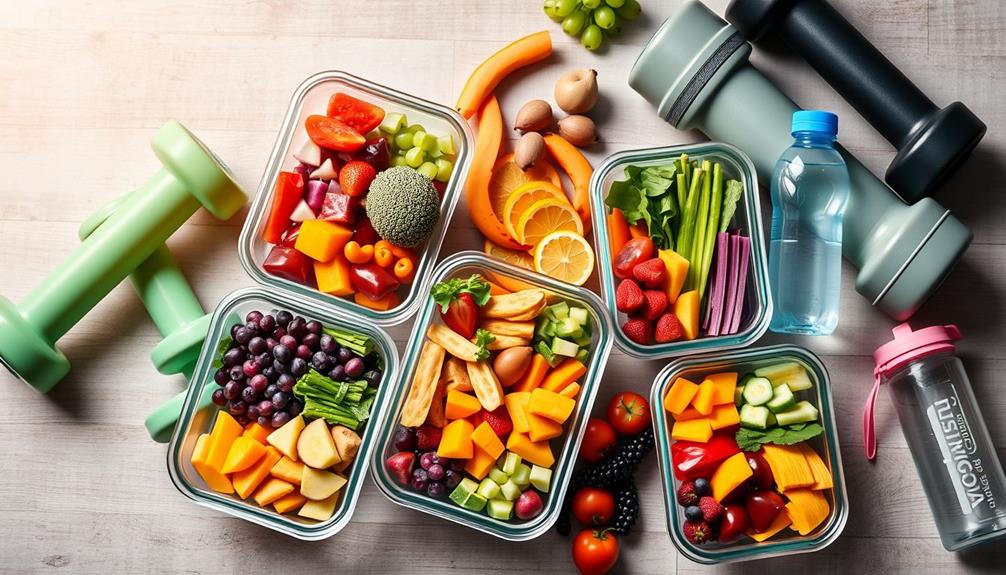
Effective meal planning is essential for anyone following a raw food diet and leading an active lifestyle. It guarantees you get the right nutrients to support your energy levels and recovery after exercise.
Here are four key strategies to take into account:
- Incorporate High-Energy Raw Foods: Include nuts, seeds, and dried fruits to provide essential calories and nutrients for sustained energy during workouts.
- Emphasize Variety: Eating a wide range of raw vegetables and fruits boosts your vitamin and mineral intake, promoting overall health and muscle recovery.
- Enhance Nutrient Absorption: Use preparation methods like soaking and sprouting for grains and legumes. This improves digestibility and increases protein and fiber availability—crucial for active individuals.
- Plan Convenient Snacks: Create smoothies and energy bars from raw ingredients. These nutrient-dense snacks can fuel your workouts and aid recovery while sticking to raw food guidelines.
Combining Raw Foods With Fitness
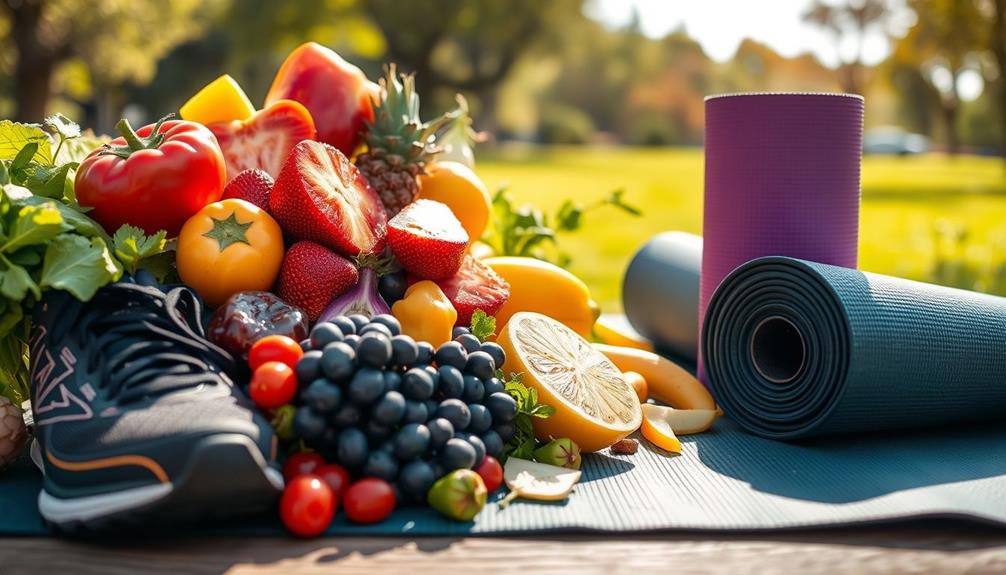
Combining raw foods with fitness can greatly enhance your performance and recovery. When you incorporate nutrient-dense raw foods into your diet, you fuel your body with the right energy needed for exercise. High in fiber, these foods help you feel full and maintain energy levels, preventing overeating and aiding in weight management.
Raw foods, such as fruits and vegetables, are typically low in calories yet packed with vitamins and minerals, making them an excellent choice for athletes and fitness enthusiasts. Adding nuts and seeds provides healthy fats and proteins, which are essential for muscle recovery after intense workouts.
Proper hydration is also important, and raw fruits and vegetables contribute considerably to your hydration levels. Staying hydrated during exercise helps optimize your performance and speeds up recovery.
Many advocates of the raw food lifestyle emphasize the importance of combining these nutrient-rich foods with regular physical activity. This synergy between raw foods and fitness not only supports your physical endeavors but also promotes overall health and well-being.
Long-term Sustainability of the Diet

Sustaining a raw food diet over the long term can present several challenges that may impact your commitment to this lifestyle. Here are some factors to take into account:
- Restrictive Nature: The raw food diet can feel limiting, making it hard to enjoy meals with friends or family.
- Nutritional Deficiencies: Without careful planning, you might face deficiencies in protein, vitamin B12, and omega-3 fatty acids, which can affect your energy levels and overall health.
- Financial Investment: The cost of organic and specialty raw foods can be high, making it a significant financial commitment that not everyone can maintain.
- Food Variety: A lack of variety can lead to boredom and feelings of deprivation, which may weaken your resolve to stick with the diet.
These challenges highlight the significance of reflecting on long-term sustainability when choosing a raw food lifestyle.
If you're serious about this commitment, finding ways to diversify your meals, manage costs, and guarantee adequate nutrition is essential.
Balancing these aspects will help you enjoy the benefits of the raw food diet while minimizing potential setbacks.
Frequently Asked Questions
Does the Raw Food Diet Recommend Exercise?
The raw food diet doesn't recommend exercise as part of its guidelines. However, you might feel more energetic and motivated to be active, which can naturally lead you to incorporate regular physical activity into your routine.
What Does the Raw Food Diet Promote?
The raw food diet promotes eating uncooked, unprocessed foods, leading to a 20% increase in nutrient intake. You'll enjoy more energy, improved digestion, and a passion for health, making it easier to embrace an active lifestyle.
What Happens to Your Body on a Raw Food Diet?
On a raw food diet, you'll experience increased energy levels, improved digestion, and enhanced muscle recovery. The high nutrient content can boost your vigor, making you feel more motivated to engage in physical activities.
What Do Doctors Say About the Raw Food Diet?
Doctors often highlight the benefits of raw food diets, like increased fruit and vegetable intake, yet they warn you about potential nutritional deficiencies and foodborne illness risks. Balance and safety are essential for your health.
Conclusion
Incorporating a raw food diet into your lifestyle can fuel your energy, enhance your workouts, and support your recovery. By embracing fresh fruits and vegetables, you not only nourish your body but also inspire your motivation. While challenges may arise, meal planning and combining raw foods with fitness can keep you on track. So, if you're ready to elevate your health, boost your performance, and transform your routine, the raw food diet might just be the perfect fit for you.




